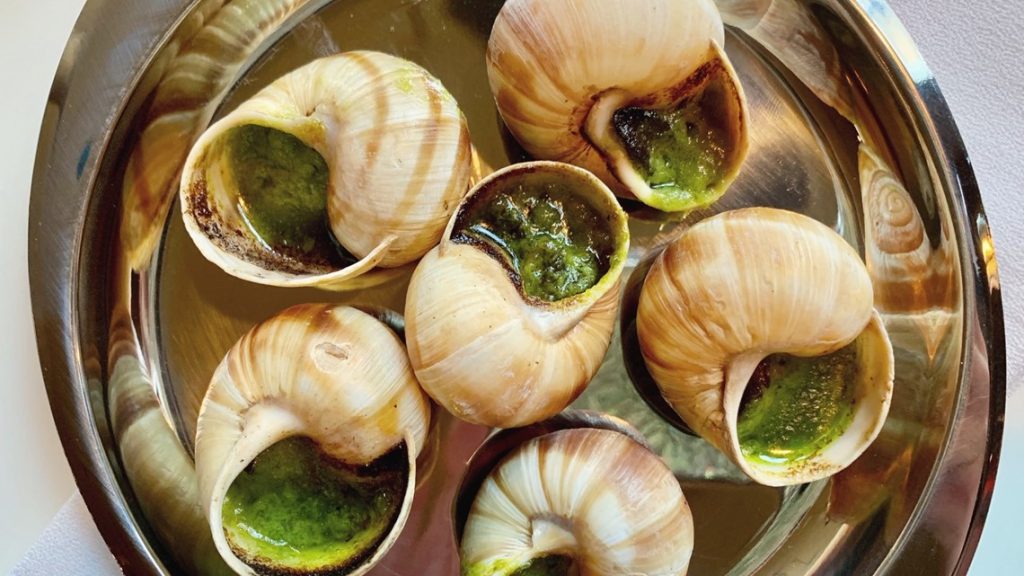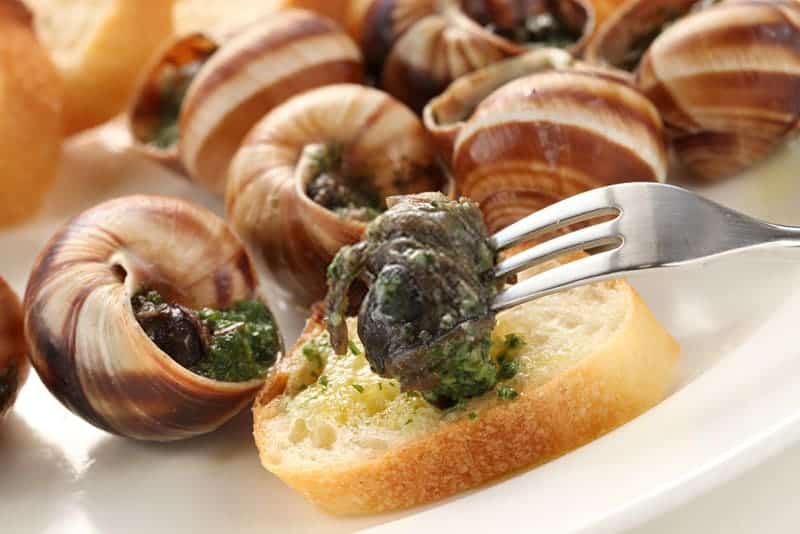Escargot, a culinary delight originating from France, is a dish that has intrigued and delighted food enthusiasts for centuries. But what does escargot taste like?
However, It offers a unique and complex flavor profile, making it a delicacy enjoyed by those who appreciate a mix of seafood, poultry, nuttiness, herbal hints, and a touch of sweetness in their cuisine.
Whether you’re a seasoned gourmet or an adventurous eater looking to expand your palate, discovering the taste of escargot is a delightful journey into the world of fine dining.
What is Escargot?

Escargot is a fancy dish made from cooked land snails, commonly served as an appetizer in French cuisine. To make it, you clean and cook the snails after removing them from their shells. The most popular way to prepare escargot is by baking them with garlic and parsley butter, which gives them a unique flavor earthy, a bit sweet, and rich from the butter. While not everyone may like it, it’s considered a delicacy in some places, especially in France and the Mediterranean.
Escargot: Texture and Taste
The texture of escargot is tender, slightly soft, and chewy, with a creamy interior that contrasts with the chewiness of the outer part. The aroma is characterized by prominent scents of garlic, aromatic herbs like parsley and thyme, and the rich, melted butter used in the dish. These factors combine to create a delicious and aromatic culinary experience.
Nutritional Benefits of Escargot
Escargot, or snail meat, is a nutrient-rich delicacy that offers a range of health benefits. In a 3-ounce serving, you’ll find approximately 76 calories and a substantial 14 grams of protein. It’s also a good source of essential minerals like iron, zinc, calcium, and Vitamin E. What’s particularly noteworthy is that it is low in carbohydrates and fats, and it’s completely free from sugar.
According to the US Department of Agriculture’s Nutrient Database, snail meat is an excellent provider of calories, protein, and essential nutrients. Furthermore, it contains tryptophan, a chemical that can positively impact your mood by promoting the release of serotonin, the “feel-good” neurotransmitter.
| Nutrient | Amount |
| Calories | 77 |
| Total Fat | 1.2 g |
| Saturated Fat | 0.3 g |
| Polyunsaturated Fat | 0.2 g |
| Monounsaturated Fat | 43 mg |
| Cholesterol | 60 mg |
| Sodium | 325 mg |
| Potassium | 1.7 g |
| Carbohydrates | 0 g |
| Sugars | 0 g |
| Protein | 14 g |
Healthy Reasons to Eat Escargot
Low-Fat Marvel:
Snails, the exquisite morsels within their shells, are inherently lean. Their minimal fat content aligns seamlessly with a health-conscious lifestyle, setting the stage for a nutritious addition to your plate.
Carb Conscious:
When it comes to carbohydrates, the primary source in an escargot dish typically stems from the sauce they’re bathed in. With snail meat being predominantly protein, there’s minimal room for unwanted carbs, making it an excellent option for carb-conscious individuals.
Protein Powerhouse:
A mere 4-ounce serving of escargot delivers a robust 18 grams of protein. This protein-rich profile, combined with its low-fat, low-carb attributes, positions it as a stellar dietary choice for those seeking a protein-packed meal.
Allergen Advantage:
In the realm of allergens, snails are a less common culprit compared to other seafood, such as shrimp or lobster. Although they belong to the shellfish family, individuals with shellfish allergies might find escargot a safer alternative.
Additional Nutritional Bonuses:
According to nutritional data, snails, depending on the cooking method, emerge as excellent sources of Vitamin E, Zinc, Calcium, and Iron. These added nutritional benefits underscore the multifaceted advantages of incorporating escargot into your culinary repertoire.
Mood Enhancement:
Moreover, contains tryptophan, a chemical that can positively impact mood by promoting the release of serotonin, a neurotransmitter associated with feelings of happiness and well-being.
Unique Culinary Experience:
Eating itoffers a unique culinary experience that can encourage adventurous eating and the consumption of a variety of foods. This diversity in the diet can contribute to overall nutritional balance.
Selecting the Finest Snails for Delectable Escargot
If you believed that plucking a few snails from your garden would guarantee mouthwatering escargot, think again. To choose the perfect snails for this culinary delight, follow these steps:
Starvation for Superior Taste: Given that they don’t share our taste for escargot, they need to undergo a week-long fasting period before becoming gastronomic stars. This crucial step purges their systems of any toxins. When procuring them, inquire about their harvest date or time, enabling you to initiate this essential process.
Freshness Matters: The best snails are those freshly harvested within a week of your purchase. Their flavor and texture are at their prime during this period.
Purging for Purity: Opt for them that have been purged. This involves a two-step feeding process. Initially, offer them grass or herbs, followed by a diet of cornmeal or oatmeal for a day or two. This practice ensures they are cleansed and ready for culinary excellence.
Properly Cleaning Snails for Scrumptious Escargot

When you’re prepared to create a delightful escargot dish, it’s crucial to clean the snails meticulously. Follow these steps for an impeccable preparation:
- Boil four cups of water in a pot, adding two tablespoons of baking soda. Submerge the snail shells in the water and boil them for approximately three minutes.
- After boiling, drain and rinse the shells, then gently pat them dry before arranging them on a baking sheet.
- Extract the membrane covering the snail shells using a knife after their baking soda bath.
- Place the snails into another pot filled with fresh water. Discard any snails that float to the surface. Gently rub two to three snails at a time with your fingers, repeating the process until all snails are cleaned.
- Once the cleaning is complete, go through the process two or three times, using fresh water each time to ensure thorough cleansing.
How to cook escargot
Ingredients:
- Snails
- 1 Garlic head
- 12 slices of baguette
- ½ cup of white wine (110 ml)
- Salt and pepper
- 1 shallot, sliced
- 4 ounces of butter (112 g)
- An ounce of parsley leaves
Directions:
- In a small saucepan, create a flavorful concoction by simmering white wine, shallot, and the snails for approximately 15 minutes. Once done, drain the snails and set them aside.
- In a food processor, finely chop parsley and garlic. Blend in the butter until it transforms into a smooth, delectable paste.
- Season the paste with a dash of pepper and a sprinkle of salt.
- If you have shells at the ready, fill them with the snails and generously spread the parsley-butter paste in the remaining space.
- Arrange them in a baking dish and let them sizzle in the oven under the broiler. Your escargot masterpiece is ready to grace your table.
- In case snail shells are unavailable, opt for baguette slices as a delightful alternative. Saute the baguette slices with butter in a saucepan over high heat. Once the butter melts, introduce the snails and savor your escargot adventure.
Perfect Escargot Pairings:
Given its rich, luscious profile, pair escargot with lighter, milder-flavored foods. Consider pairing It with broccoli, zucchini, tomatoes, pumpkin seeds, salad mixes, cereal, cheese, asparagus, carrots, mushrooms, bell peppers, and an array of vegetables.
FAQs
1. Why Do People Eat Escargot?
People indulge in escargot for its distinctive taste, texture, and the elite tradition associated with it. While it can be expensive, it offers unique flavors and nutritional benefits that make it a sought-after delicacy.
2. Do Escargots Taste Good?
Yes, Escargots have a unique taste and texture that many find enjoyable, especially when prepared with ingredients like butter, garlic, and parsley. The flavor can be enhanced with various seasonings and herbs, making it a delectable treat for those who appreciate its distinct profile.
3. Does Escargot Taste Like Mussels?
No, Escargot and mussels are not similar in taste. Mussels have a salty, fishy flavor and a chewy texture, while escargot’s taste depends on the seasonings and herbs used. Escargot doesn’t taste like mussels, but both can be enhanced with seasoning agents.
4. Does Escargot Taste Like Dirt?
No, Escargot’s taste varies from person to person but is often described as resembling fried fish, chicken, or mushrooms. Some liken it to a combination of mushroom and calamari, but in a tasty way, rather than resembling dirt.
5. What Does Sea Snail Taste Like?
Sea snail offers a succulent, salty flavor with a meaty texture. The taste can be further enhanced with condiments like lemon, salt, crushed peanuts, and chili, depending on the seasoning.
6. What Does Raw Snail Taste Like?
Raw snail has an earthy flavor, but consuming it raw is strongly discouraged due to safety concerns. Raw snails can carry diseases like rat lungworm, which can be transmitted to humans.
7. What Does Snail Caviar Taste Like?
Snail caviar, or escargot roe, has a rich, earthy flavor with subtle woody notes. It’s comparable to the taste of baked asparagus or mushrooms, making it a luxurious gourmet option.
8. Is Escargot Healthy to Eat?
Yes, Escargot can be a part of a healthy diet as it is a good source of protein and contains essential nutrients like iron, zinc, calcium, and Vitamin E. However, like any food, moderation is key, especially considering the butter and seasonings often used in escargot preparation.
Final Words
In conclusion, the taste of escargot is a unique and multifaceted experience, offering a blend of seafood, poultry, nuttiness, herbal notes, and a subtle sweetness. The creamy, tender texture of the snail meat complements the diverse flavor profile.
Further, Its appeal lies in its ability to harmonize with a range of seasonings and herbs, elevating its taste. While it may not be to everyone’s palate, those who appreciate this delicacy find its distinctive combination of flavors and textures to be an enticing culinary adventure. Lastly, it is more than just a dish; it’s a delightful exploration of taste and tradition.

